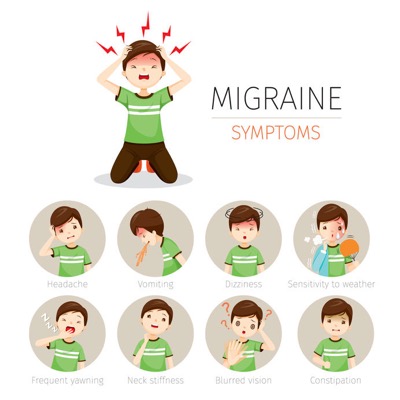- Home
- Essential Oils for Healing
- Pain Relief
- Migraine
As an affiliate for Bookshop, Amazon, and other programs, I may earn a small commission for products purchased through links. This doesn't affect the price you pay. Privacy policy and disclosures.
Search this site:
Using Essential Oils for Migraines
Using essential oils for migraines to help relieve the pain may help you reduce or avoid medication that can have undesirable side effects. Consult your healthcare provider to know for sure your headaches are migraines. Severe pain doesn't always indicate a migraine and could be a severe tension headache. Also, you want to know you don't have another serious underlying medical condition.

Best Essential Oils for Migraines
You can use essential oils for migraine pain relief and perhaps prevention. Everyone is different, and no one essential oil or blend will work for all people — experiment!
Lavender for Migraines
One technique that might stop a migraine you feel coming on is to:
- Fill a basin with 110-degree-Fahrenheit water.
- Stir 5 drops of lavender essential oil into the water. (Another option is 4 drops lavender and 4 drops ginger essential oil.)
- Soak your hands in the water for a few minutes.
Or you could use an aromatherapy for migraines compress:
- Mix 5 drops of lavender essential oil into 1 cup cold water (or use 3 drops lavender and 3 drops peppermint).
- Soak a soft cloth in the water.
- Place the cloth over your forehead and eyes.
- Repeat as desired.
Source: Healing With Aromatherapy
Note: You can use hot water if you like, but most people with migraines prefer cold. You can also alternate hot and cold. Or use a cold lavender compress on your forehead, while at the same time using a warm compress with marjoram essential oil on the back of your neck.
If using a compress is inconvenient, other options are to diffuse an essential oil or blend with an aromatherapy diffuser or use an aromatherapy inhaler that you can carry with you.
Other Essential Oils for Migraine Relief
If lavender doesn't work for you, other essential oils for migraine headaches that you can diffuse or use in a compress are:
- Basil
- Eucalyptus globulus
- Helichrysum
- Marjoram
- Peppermint
- Roman chamomile
- Rosemary
- Wintergreen
Source: Aromatherapy for Health Professionals
Use this migraine essential oil blend in a compress or dilute in carrier oil for neck and shoulder massage:
- 1 drop frankincense essential oil
- 1 drop peppermint essential oil
- 1 drop basil or cypress essential oil
- 1 drop lavender essential oil
Source: Essential Oils For Healing / The Essential Oils Complete Reference Guide
Here's an even stronger blend of essential oils for migraines:
- 7 drops peppermint essential oil
- 7 drops lavender essential oil
- 2 drops copaiba essential oil
- 2 drops frankincense essential oil
- 2 drops wintergreen essential oil
- 2 tablespoons carrier oil
Blend all the oils in a small glass jar. To use, massage a little of the blend over the temples and back of neck at the first sign of a migraine.
Source: The Healing Power of Essential Oils
Massage for Migraine Pain Relief
Combining massage with migraine essential oils gives you a double benefit. Massage helps relieve stiff, tender muscles in the back of the head, neck, and shoulders and alleviates trigger points that cause pain. Massage therapy is also great for relieving stress.
A few studies have shown that, at a minimum, massage therapy helps people who experience migraines sleep better and often significantly lessens headache pain. Massage is most effective when received regularly, ideally once a week until you experience fewer headaches.
When receiving massage therapy, be aware that mild discomfort can occur with even light, very gentle pressure from the most qualified massage therapist. However, if the pain becomes intense, immediately tell the therapist to stop.
Self Care for Migraine Pain Relief
Migraine pain relief often requires a multi-faceted approach, including dealing with stress and physical imbalances.
Relaxation techniques are safe with almost no side effects, although a few people might experience more anxiety rather than less. You can do the following relaxation techniques almost anywhere at any time:
- Deep breathing: Breathe in through your nose as much as you comfortably can, letting your abdomen gently expand. Hold your breath for 3 to 5 seconds, and then exhale slowly through your mouth. Repeat for three or four breaths several times a day.
- Active relaxation: Starting with the muscles in your feet, tense and then relax each muscle group in the body until you reach your head.
- Stretching helps loosen tight muscles and relieve stress.
- Meditation and self-hypnosis are important relaxation techniques for relieving pain and stress. Meditation has four elements: a quiet environment, a point of focus such as a neutral word to help with concentration, being in a comfortable position, and an accepting attitude. Meditating one or two times a day for 10 to 20 minutes can relieve chronic stress and also increase your ability to tolerate stress.
- Visualization involves using your mind to imagine how you can successfully deal with a stressful situation. Picture the stressful situation in your mind and then rehearse the outcome you want. You can also use visualization techniques to imagine a peaceful scene that you find relaxing.
Other factors to consider include diet, which can trigger migraines for some people. Watch out for these foods:
- Alcoholic drinks (especially red wine)
- Foods containing the amino acid tyramine (such as, sour cream, yogurt, and aged cheeses)
- Dairy products
- Chocolate
- Foods that contain additives (such as nitrites, aspartame, or MSG)
Lifestyle factors that can trigger migraines include change in sleep habits, overuse of headache medicines, too much stress, and environmental factors such as weather changes, high altitudes, loud noises, strong odors, of fluorescent or bright lights or bright sunlight.
You might want to keep a food, lifestyle, and headache diary to see you if can find a correlation between these factors and your headaches.
Emotional factors can also trigger migraines. If you want to address the emotional component of your migraines or any other condition, I highly recommend You Can Heal Your Life by Louise Hay.
Buy essential oils from Aromatics International (recommended).
Rocky Mountain Essential Oils.
Photo Credit: 123RF


